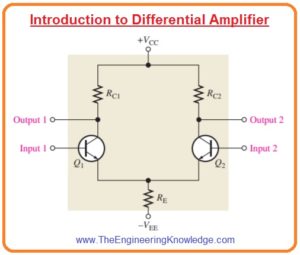 Hello friends, I hope you all are doing great. In today’s tutorial, we will have a look at Introduction to Differential Amplifier. It is a type of amplifier which amplify the difference of two input signal. There are 2 modes of operation for this amplifier first is a common mode in which both inputs are the same and the second one is a differential mode in which two inputs are different.
Hello friends, I hope you all are doing great. In today’s tutorial, we will have a look at Introduction to Differential Amplifier. It is a type of amplifier which amplify the difference of two input signal. There are 2 modes of operation for this amplifier first is a common mode in which both inputs are the same and the second one is a differential mode in which two inputs are different.
This amplifier configuration is normally used in analogue ICs circuits arrangements. In today’s post, we will have a detailed look at its working, circuit and related parameters. So let’s get started with Introduction to Differential Amplifier.
Introduction to Differential Amplifier
- In below figure the basic differential amplifier circuit is shown.
- You can see that this circuitry has 2 inputs and 2 outputs.
- The below figure define the dc bias analysis of differential amplifier.
- First of all the voltage across both inputs is zero volts and both emitters have voltage -0.7 volts as shown in figure denoted as (a).
- It is supposed that transistors are definatly matched with each other during construction so their dc emitter currents are at same level when thre is no voltage at inputs.
IE1=IE2
- As both emitters current linked through the reistance RE.
IE1=IE2=IRE/2
- Here
IRE=(VE-VEE)/RE
- According to estimation, we have IC=IE
IC1=IC2=IRE/2
- As both collector currents and collcetot resistances are same for zero input voltage.
VC1=VC2=VCC-IC1RC1
- This condition is defined in figure denoted as (a).
- In figure denoted as (b) input 2 is connected with the ground and positive biased voltage provided at input one.
- The positive voltage at the base of transistor Q1 increases the IC1 that decreases the VC1 and decrement in IC2 cause an increment in VC2.
- In figure denoted as (c) input, one is at connected with the ground and second input connected with the positive bias voltage.
- Positive bias voltage causes the transistor Q2 to operate more that increases current IC2.
- Also, the value of the emitter voltage is increased.
- It decreases the forward biasing of transistor Q1 as its base is connected with the ground that causes current IC1 to decrease.
- The consequence is that the increment in current IC2 generates a decrement in VC2 and the decrement in current IC1 cause voltage VC1 to increase.
Modes of signal operation
Single ended differential point
- When differential amplifier has such configuration in which one input is at ground level and at other input voltages is provided. It is shown in figure.
- The condition when voltage is provided to first input as denoted in figure (a) inverted amplified signal voltage is shown at output one.
- With that signal voltage exits in phase at the emitter of transistor Q1.
- As the emitters of transistor Q1 and Q2 are common the signal of the emitter will be input to the transistor Q2 that operates as common emitter amplifier.
- In figure denoted as (b) signal is provided to the input two and first input is connected with the ground.
- In results, an amplified inverted signal appears at the output two.
- In this condition transistor, Q1 operates as a common base amplifier and a non-inverted signal is shown at output one.
Double-ended differential inputs
- In this input arrangements, 2 signals of opposite polarity are given to the input it shown in below figure denoted as (a).
- Every input has an effect on the output.
- Figure denoted as (b) shows the output voltage at due to signal at input one working as single-ended input.
- Figure denoted as c shows the output voltage due to the voltage at second input working as single-ended input.
- You can note that in circuits denoted as (b) and (c) polarity of a signal at input one is same.
- It also for output two both are the same polarity.
- By superimposing both outputs one voltage signals and both output 2signals you will get total output signal as shown in figure denoted as d.
Common mode input
- The most important factor of operation of differential amplifier can be seen to take into consideration common-mode condition.
- In this condition two signal voltage of similar frequency, phase and amplitude are provided to the 2 inputs of an amplifier as shown in figure denoted as (a).
- By taking single input at one time we can understand the operation.
- Figure denoted as (b) shows the output due to the signal only on the first input.
- Figure denoted as (c) shows the output voltage signal due to the signal voltage at input two.
- Note that resultant signals at on output one have opposite polarity and are on output two.
- If input signal is given at the both of signals the output will be superimposed and resultant will be zero output voltage shown in figure denoted as d.
- This process is known as common-mode rejection.
- This mode important for such condition when an unwanted signal comes at both inputs of differential amplifiers.
- Common mode rejection mode means that the undesired signal will not be shown at the output and not disturb the original signal.
- Common mode signal or noise is the consequence of the radiated energy on the input lines from neighbouring lines such as sixty hertz or other sources.
Common mode Rejection Ratio
- Required signal is obtained at single input or one both inputs having opposite polarity.
- These required signals are get amplified and shown on the output as we have discussed above.
- Undesired signal existing at both input lines with the same polarity will cancel through the differential amplifier and not shown at the outputs.
- The measurement of amplifiers ability to reject common mode signal is a factor known as common mode rejection ratio or CMRR.
- In ideal condition differential amplifier gives large value of gain for required signal and 0 gain for common mode signal.
- But practical differential amplifier gives very less value of common mode gain normally less than one while shows large differential voltage gain normally several thousand.
- The greater the differential gain of amplifiers with respect to common mode gain the performance of amplifier in term of rejection common mode signal.
So, friends, it is a detailed post about differential amplifier if you have any question ask in comments. Thanks for reading.


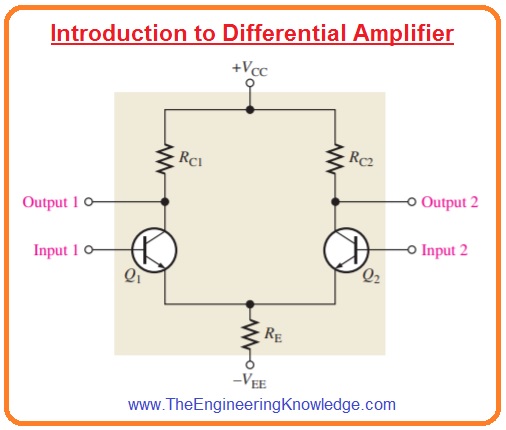
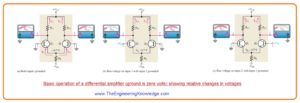
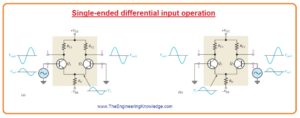

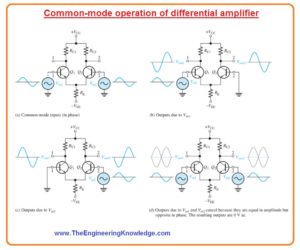



Please contact me on Whatsapp: 44 7379 059887
I would love to talk with you guys 🙂
you can send me your queries I will guide you